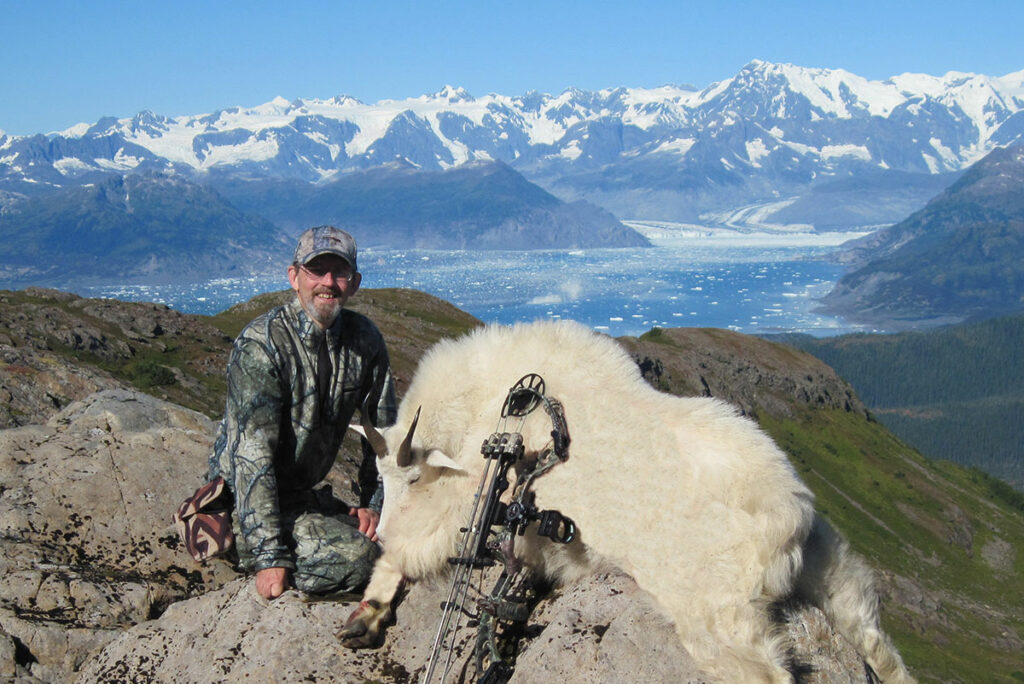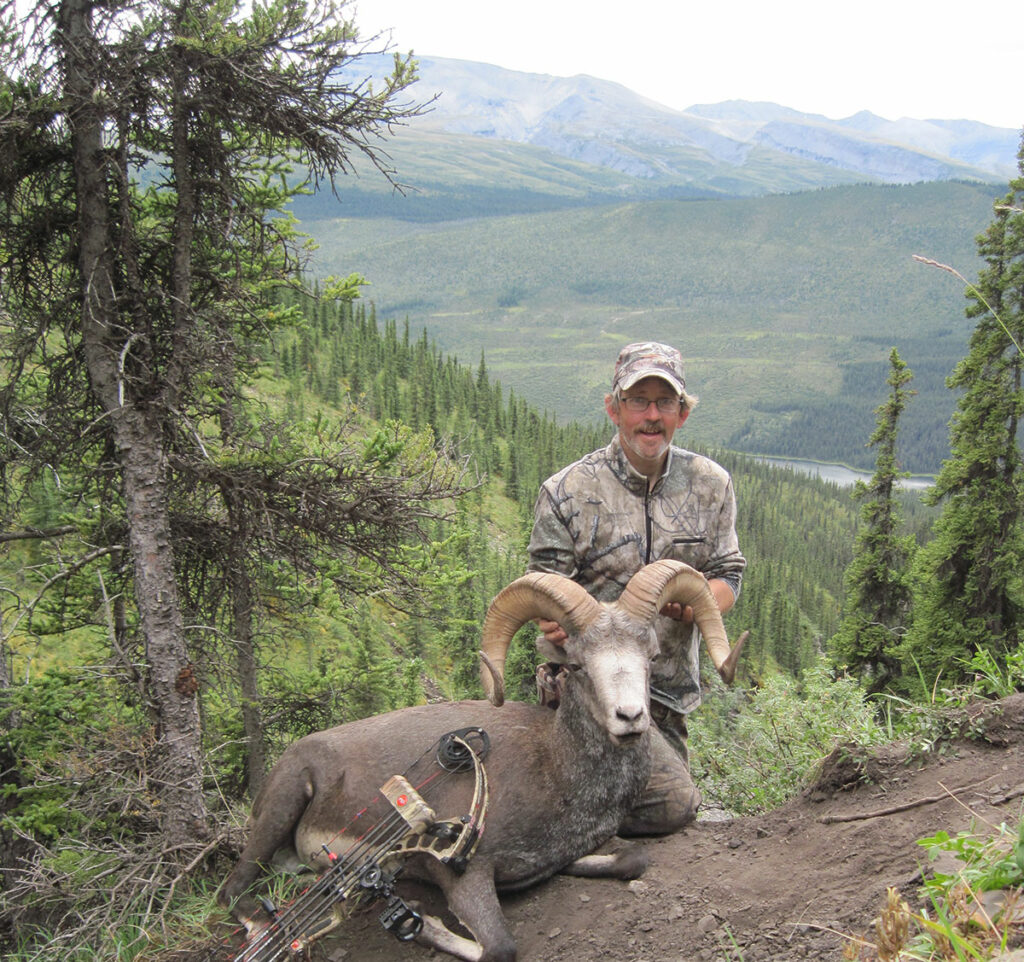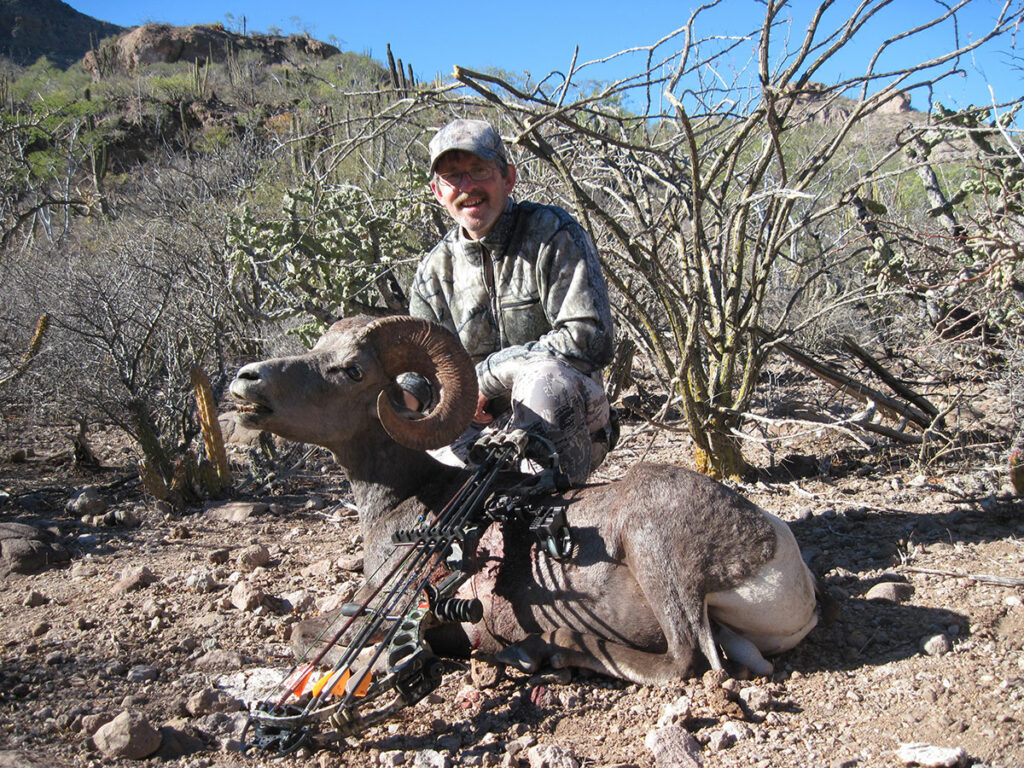Bowhunting Mountain Game
Mountain hunts are tough regardless of your method of hunting. However, when your weapon of choice is a bow and arrow, the degree of difficulty can increase significantly. The terrain alone presents challenges that at times will test the mental and physical mettle of even the fittest hunter. The mountain bowhunter must also contend with fickle mountain winds. Rocky crags, steep ravines and patches of timber can often lead to unexpected changes in wind direction during a stalk and thereby dictate that the bowhunter back out before being detected.
The mountain bowhunter must also be patient. During most of the mountain hunts that I have taken, finding a legal ram or billy was not my biggest problem. Finding a legal ram or billy in a stalkable position, well that is another story. It has been my experience that when you find a legal animal, he is usually not alone. For example, mountain sheep like to bed where they can watch in several directions for danger. Stalking undetected into bow range of a band of several rams can at times be impossible, requiring the bowhunter to wait, sometimes for several days, until the animals split up or move to a location that is more conducive for a stalk.

As in other big game bowhunts, the weather will also be a major factor in the mountains. One mountain goat hunt that I took in coastal British Columbia comes to mind. My guide and I began that hunt by taking a small float plane to an alpine lake high in the coastal mountains. We unloaded our gear and hiked into the mountains above the lake. It took us most of the first day to get high into the alpine and find a good place to set up our tents. We spent the entire second day of the hunt in our tents while it rained, until we discovered that we had set up our camp in a low spot that was starting to fill with water. It is no fun moving tents in a blowing rain storm, but if we had not moved them, we would have no doubt floated off of the mountain. The next day, we couldn’t see more than twenty yards due to fog. After several more hours in our tents, the winds picked up and blew out the fog. We grabbed our binoculars and started glassing. The wind had blown in an ice storm, causing everything to be coated with a layer of ice. We waited another day in the tents before we could actually start hunting.
At some point during many of the mountain hunts that I have taken, I typically find myself wishing for dry warm weather. But the old adage “be careful what you wish for” is particularly relevant here and can be explained with one word: BUGS! Once the rain, snow and/or ice stops and the sun comes out to burn off the fog, that is the cue for the incessant swarms of black flies to commence feasting on every portion of exposed flesh. During that hunt in British Columbia, once the ice storm had passed and the sun came out, we were covered in black flies. I had packed a light bug net jacket, but my guide had forgotten his. We did have bug dope, but I swear that the black demons were attracted to it. I felt sorry for my guide but not sorry enough to offer him my jacket that had a built-in headnet.
Guided mountain hunts are also expensive. Tags for mountain sheep are limited. Unless you are lucky enough to draw one in the States, you must go to Canada or Mexico and purchase a tag or buy a coveted auction tag. The costs associated with getting you and your guide safely into the alpine and back can also be expensive. Bush planes, helicopters, horses, boats, or a combination of these modes of transportation are often employed to get the hunter and guide deep into the mountains. The mountain bowhunter may hunt several days and only get one opportunity. One arrow may have several thousands of dollars riding on it as it leaves the bow , which only adds to the mental and physical stress that the hunter had to endure to even get to that point.
Despite all of these challenges, I look forward to every opportunity that I get to bowhunt in the mountains. What follows is a brief description of some of the approaches that have helped me and some of my friends to prepare for a hunt in the mountains and see it through to a successful harvest.

First, I have found that if you are committed to harvesting your animal with your bow, then you should leave your rifle at home. This allows you to avoid any likelihood of being tempted to use the rifle when the going gets tough and you see a great animal that is not in a stalkable position for a bow shot. However, if you are hunting in country where you may encounter a grizzly bear, your guide may carry a gun. If that is the case, you should make it clear to your guide prior to beginning your hunt that you have no interest in using the rifle and not to offer it to you should the hunt become difficult. Another possibility would be for you and your guide to carry bear spray for protection. Of course, safety should be your first consideration, but if you do not have a gun along you won’t be tempted to use it.
This need to leave your rifle at home was further reinforced by a couple of hunters who I met in base camp prior starting a dall sheep hunt in the Northwest Territories. These hunters had just returned from hunting sheep and mountain caribou and both hunters had each harvested a great ram and a good bull caribou. They each had begun their hunt with bow in hand.
The one younger hunter confessed that after hiking up some steep slopes on the first day, he wanted to quit. His guide kept encouraging him to keep going though, and eventually they found a group of rams to stalk. However, due to his level of exhaustion, he decided to use his guide’s rifle to harvest his ram. He had a similar story about bagging a beautiful caribou bull the very next day.
As he talked, I could see hints of disappointment on his face. Even though he bagged two beautiful trophies in just two days of hunting, he was obviously unhappy that he was unable to harvest the animals with his bow. The other hunter had a similar story. This was both hunters first introduction to mountain bowhunting. When I asked them how they had prepared for this hunt, they both indicated that they had spent time lifting weights in the gym, and they had also done some hiking with their packs on. The one guy proclaimed, “I fully underestimated how difficult this type of hunt would be, particularly using a bow.” They both vowed that they would be coming back to take their animals with their bows.
It is typical for me to be very motivated and full of energy during the first few days of a mountain hunt. After days of hiking, glassing and eating freeze dried food, my motivation and energy levels can start to decline. For those low times, I carry a three by five inch card that contains some of my favorite motivational quotes. I also sometimes take photographs of past successful hunts, especially those that were not successful until late into the hunt. I keep these photos where I can easily access them, even while hiking. I find that when I am beginning to slow down and negative thoughts start to creep in, a quick glance at the card and photos can help to spur me on.
I also take along a small i-pod with some of my favorite music on it. I have found that after a long unsuccessful day of hiking, listening to some music in my tent can help me refocus and become reinvigorated for the next day.
Most guides on mountain hunts carry a satellite telephone for safety purposes. On my last two mountain hunts, I took my own satellite telephone with me. In addition to serving as a backup to the guide’s telephone for safety reasons, my satellite telephone allows me to stay in touch with the people back home. You can also take an InReach device that enables you to send text messages while on the mountain. I have a very good friend who is a veteran of many mountain hunts. He is always available for me to call to offer encouragement after a long unsuccessful day of hunting.
Another trick that a friend of mine uses is to break up the hunt into smaller segments. For example, a nine day hunt becomes three, three day hunts. He focuses his energy and thoughts on getting through the first three days. Then he concentrates on getting through the next three days and so on. I have even applied his approach when I am hiking up a long, steep hillside with a heavy pack on. Sometimes when I look up the mountain to the place where we are headed, it can become overwhelming and I start to doubt whether I have the energy to make it to the top. When these thoughts start to enter my mind, I pick out points along the way (a rock, a bench, a bush, etc.) and set them as goals. For example, I might tell myself, when I make it to that white rock, I will take a breather. I don’t stop until I get there. Before I know it, I am at my destination looking down the mountain wondering how I ever mustered the energy to get there.

Don’t forget to practice your shooting. Most of my mountain hunts involved shots at relatively steep angles. The animal may be above you, or it may be below you. Don’t just practice shooting on level ground. Often times, you will only get one or two shot opportunities during a hunt. You need to be familiar with shooting at these different angles. I also recommend that you take an angle compensating range finder with you and make sure that your sight pins are calibrated to it. I actually take two identical range finders with me and give one to my guide. Depending upon the situation, the guide may be able to range the animal and whisper out the range while you come to full draw. It has worked for me on several occasions. It also affords me with a backup should one of the rangefinders quit working.
Mountain goats and sheep are majestic animals. They live in areas that few people will ever have the privilege to visit. The terrain and environment can be unforgiving and both mentally and physically challenging. Preparation builds confidence, and it is confidence that will help carry you through the hard times on the mountain. Good hunting!–Tom Edgington

